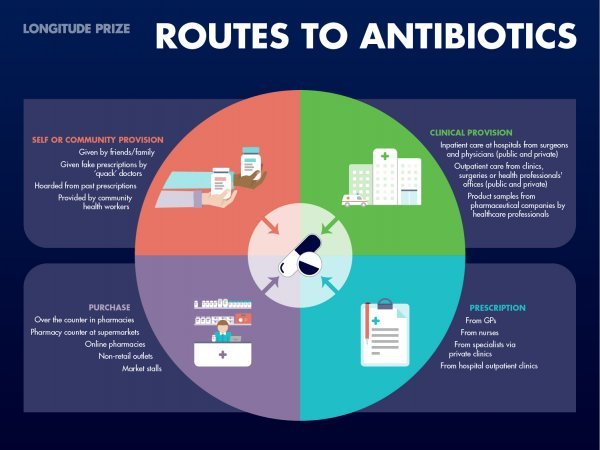Longitude Prize: what do we mean by point-of-care?
04 May 2017
Point-of-care testing exists on a spectrum, ranging from ultra high-tech tests used in hospitals through to simple self-tests for use by patients at home. With the Longitude Prize’s aim being to reduce inappropriate antibiotic use worldwide, where would the winning test fit in?
What is a point-of-care test?
The definition of point-of-care generally refers to the location where a diagnostic test is carried out. In a nutshell, point-of-care tests are carried out in close proximity to a patient, meaning the overall time taken for testing is reduced. Varying definitions exist but the most important thing to note is that a truly point-of-care test is one that is not carried out in a laboratory.
The Longitude Prize definition of point-of-care (POC) refers to where a patient presents with illness. The National Institutes of Health definition goes even further, listing the locations where point-of-care testing may be used.
Longitude Prize definition of POC:
“Point-of-Care is the specific location at which a patient is presenting with illness – this could be at home, or in a range of primary and secondary healthcare settings. Point-of-Care diagnosis therefore takes place close to the patient, rather than at a physically removed central laboratory.”
National Institutes of Health definition of POC:
“Point-of-Care testing allows patient diagnoses in the physician’s office, an ambulance, the home, the field, or in the hospital. the results of care are timely, and allow rapid treatment to the patient…”
In addition to being carried out close to patients, point-of-care tests are carried out by non-laboratory staff. Doctors, nurses, healthcare workers, or even patients themselves can carry out a point-of-care test.
Can a lab-based test win the Longitude Prize?
Point-of-care testing provides quicker results than traditional laboratory-based testing, which is essential when trying to diagnose illnesses that require prompt treatment. This is partly because the test itself is rapid, but also because testing is carried out at a location close to the patient. This reduces the steps needed between taking a sample and issuing results – that is, the total turnaround time.
Lab testing involves several steps between sample collection and getting a result: transportation of the sample to the lab, correct receipt and labelling of the sample, entering results into a database, and communicating results back to clinicians. This is the case even when tests are carried out at an on-site laboratory, and the turnaround times are usually in the range of hours. Point-of-care testing eliminates most of these steps.
We regularly come across teams working on tests that are intended to be used in a hospital-based laboratory, which they refer to as point-of-care. While not a central laboratory, a hospital-based test would not win the Longitude Prize. Firstly, the turnaround time is too high; secondly, hospital-based lab testing is not straightforward in lower and middle income countries.
In Africa, peripheral labs are not easily accessible and the lowest category of healthcare centres often do not possess labs. Even the labs in existence are often under-resourced with limited staff, reagents and supplies. A point-of-care test available outside a lab would therefore improve access to testing and be able to diagnose many more patients.
The Longitude Prize is about more than correct diagnosis
Point-of-care testing should minimise the time it takes to obtain a diagnosis, with the ultimate effect of reducing the time it takes for the patient to begin treatment, if needed. In short, it should affect the treatment or care pathway.
When many people think of healthcare they automatically think of care given by a health worker, be that a doctor, nurse or midwife, within the confines of a hospital or a doctor’s office. As a result, it seems natural to think of point-of-care testing within that same framework – these are tests that are available to be used by clinicians in healthcare centres.
To address the challenge of reducing drug-resistant infections however, developing a successful point-of-care test isn’t just about accurately diagnosing patients and starting treatment. Any successful diagnostic test for bacterial infections should reduce inappropriate antibiotic use and misuse: this is the aim of the Longitude Prize. This means the test should be available not just where people receive care, but where they are able to access antibiotics.
In the UK, USA and other developed countries, antibiotics are almost always accessed via a prescription issued at a GP surgery, hospital, or outpatients clinic. Unfortunately, it’s not quite that simple elsewhere in the world, as shown in the infographic below.

Antibiotics are available in myriad ways. In many countries patients can buy antibiotics over-the-counter, or even from market stalls, without a prescription. If a patient can obtain antibiotics without accessing healthcare, point-of-care tests aimed solely at hospitals, GP surgeries or outpatient clinics won’t be able to reduce misuse or overuse in certain settings by ruling them out as a treatment option.
So, how do you win the Longitude Prize?
The Longitude Prize is aiming to reduce inappropriate antibiotic use on a global scale. This means the winning test should be a rapid point-of-care diagnostic for use outside of a lab, and accessible across the full range of settings where antibiotics can be accessed. The test that wins should be usable by anyone from a patient or a minimally trained healthcare worker in a pharmacy through to a clinician in a hospital.
Think you have a test that could win? Take a look at our prize rules and register your team.
